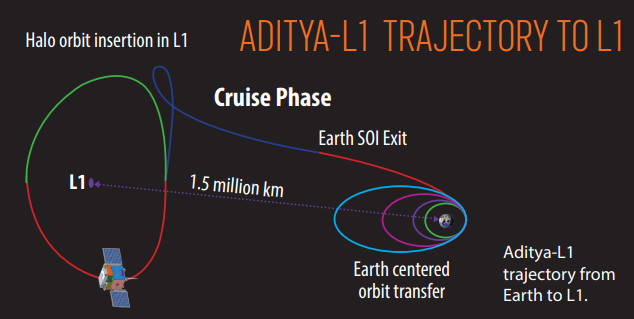ADITYA-L1
Aditya-L1 mission would be the first space-based Indian observatory to study the Sun. It is expected to launch around the end of August to early Sep 2023 and will cost around 378 crore.

What is Aditya L1 mission?
The ISRO said upon its launch, the spacecraft
shall be placed in a “halo orbit around the Lagrange point 1 (L1) of the Sun-Earth system, which is about 1.5 million km from the Earth.” The chosen site is important for giving an advantage to continuously view the star without any occultation/eclipses, the ISRO explained. One of the mission's key objectives is to monitor the impact of solar activities on space weather in real-time. Through the mission, ISRO hopes to understand the problems of “coronal heating, coronal mass ejection, pre-flare and flare activities and their characteristics, dynamics of space weather, propagation of particles and fields, etc,” it said
Aditya L1 will contain seven payloads to observe the photosphere, chromosphere and the outermost layers of the Sun, the ISRO said. The module will have electromagnetic particle and magnetic field detectors to carry out the studies.
Among the seven payloads, four will be engaged in directly viewing the Sun from the special vantage point L1; while the other three will carry out studies of particles and fields at that point to deduce the effects of solar dynamics in the interplanetary medium
Aditya L1 shall be the first space based Indian mission to study the Sun. The spacecraft shall be placed in a halo orbit around the Lagrange point 1 (L1) of the Sun-Earth system, which is about 1.5 million km from the Earth. A satellite placed in the halo orbit around the L1 point has the major advantage of continuously viewing the Sun without any occultation/eclipses. This will provide a greater advantage of observing the solar activities and its effect on space weather in real time. The spacecraft carries seven payloads to observe the photosphere, chromosphere and the outermost layers of the Sun (the corona) using electromagnetic and particle and magnetic field detectors. Using the special vantage point L1, four payloads directly view the Sun and the remaining three payloads carry out in-situ studies of particles and fields at the Lagrange point L1, thus providing important scientific studies of the propagatory effect of solar dynamics in the interplanetary medium.
The suits of Aditya L1 payloads are expected to provide most crucial informations to understand the problem of coronal heating, coronal mass ejection, pre-flare and flare activities and their characteristics, dynamics of space weather, propagation of particle and fields etc.
Objectives:
- *Study of Solar upper atmospheric (chromosphere and corona) dynamics.
- *Study of chromospheric and coronal heating, physics of the partially ionized plasma, initiation of the coronal mass ejections, and flares
- *Observe the in-situ particle and plasma environment providing data for the study of particle dynamics from the Sun.
- *Physics of solar corona and its heating mechanism.
- Diagnostics of the coronal and coronal loops plasma: Temperature, velocity and density.
- *Development, dynamics and origin of CMEs.
- *Identify the sequence of processes that occur at multiple layers (chromosphere, base and extended corona) which eventually leads to solar eruptive events.
- Magnetic field topology and magnetic field measurements in the solar corona .
- *Drivers for space weather origin, composition and dynamics of solar wind .
Aditya-L1 Payloads:
The instruments of Aditya-L1 are tuned to observe the solar atmosphere mainly the chromosphere and corona. In-situ instruments will observe the local environment at L1. There are total seven payloads on-board with four of them carrying out remote sensing of the Sun and three of them carrying in-situ observation.
Lagrange Points:
For a two-body gravitational system, the Lagrange Points are the positions in space where a small object tends to stay if put there. These points in space for a two-body system such as the Sun and Earth can be used by spacecraft to remain at these positions with reduced fuel consumption.
Technically at Lagrange point, the gravitational pull of the two large bodies equals the necessary centripetal force required for a small object to move with them. For two body gravitational systems, there are total five Lagrange points denoted as L1, L2, L3, L4 and L5. The Lagrange points for the Sun-Earth system are shown in the figure. The Lagrange point L1 lies between the Sun-Earth line. The distance of L1 from Earth is approximately 1% of the Earth-Sun distance.
The spacecraft will have the advantage of continuously observing the Sun without any occultation or eclipse thanks to its positioning in the unique vantage point of L1. This will enable us to comprehend the Sun and how it affects Earth better. The information acquired from the mission will help us better understand and predict space weather phenomena like solar flares, CMEs, solar wind, and other phenomena that have an impact on the operation of space technology near or on Earth as well as other planets.












0 Comments